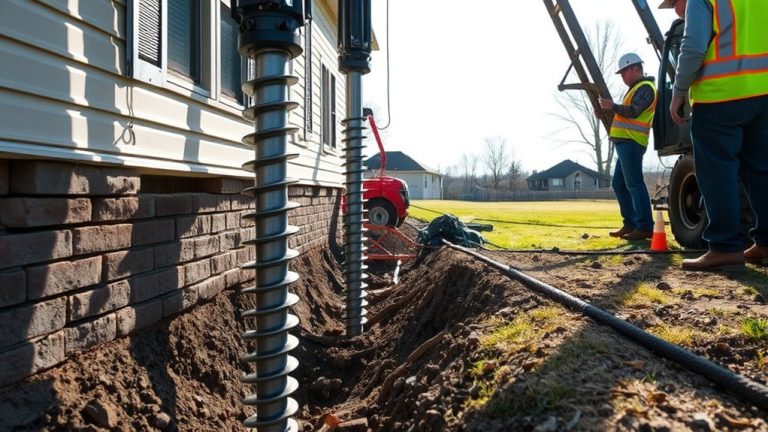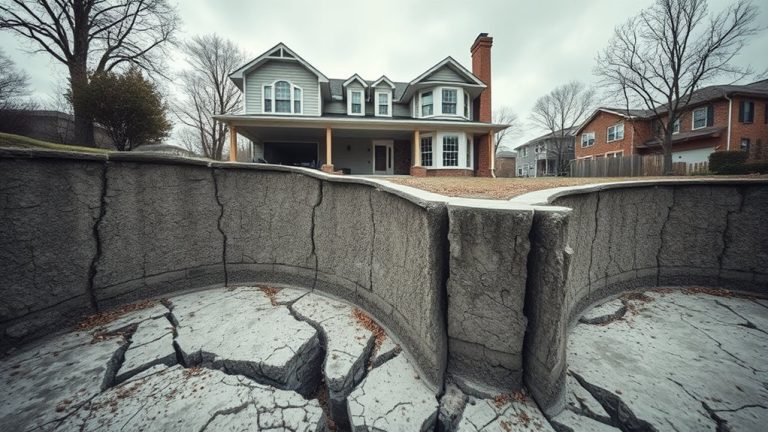You might not realize it, but the beautiful trees surrounding your home could be silently threatening its foundation. Tree roots are persistent seekers of water and nutrients, and they'll expand through soil with surprising force. When these roots grow too close to your home, they can create immense pressure that cracks concrete and destabilizes structural integrity. Want to understand how this happens and protect your most prized asset? Keep reading.
Key Takeaways
- Tree roots naturally seek moisture and can aggressively expand underneath foundations, creating hydrostatic pressure that compromises structural integrity.
- High-risk tree species like maple, oak, willow, elm, and poplar have shallow, invasive root systems that rapidly track and penetrate water sources near buildings.
- Foundation damage from root intrusion manifests through visible warning signs including horizontal/stair-step cracks, uneven floors, sticking doors/windows, and structural shifting.
- Preventative strategies include strategic tree placement, installing root barriers, regular pruning, maintaining safe distance between trees and foundations, and professional landscape assessments.
- Professional structural engineers and landscape experts can provide advanced root system mapping, risk evaluations, and recommend precise mitigation techniques like targeted pruning or strategic tree removal.
Understanding Root System Mechanics
Tree roots are far more complex and versatile than most homeowners realize. They seek water and nutrients by expanding through soil, carefully tracking moisture levels and modifying their growth patterns. Hydrostatic pressure from roots can cause significant foundation damage by pushing against basement walls and creating structural instability.
Your foundation becomes vulnerable when roots detect consistent water sources nearby, creating potential structural risks. Understanding how these underground networks function can help you protect your property effectively.
Roots spread horizontally and vertically, exploring soil conditions and searching for ideal environments. They're persistent and intelligent systems that can maneuver around obstacles, making strategic decisions about growth direction and resource acquisition.
Signs of Foundation Damage From Tree Roots
As roots continue their underground quest for resources, they can wreak havoc on your home's foundation, leaving behind telltale signs of potential structural damage. You might notice a cracked foundation, which isn't just a cosmetic issue but a serious structural warning. Horizontal and stair-step cracks can indicate severe foundation damage caused by aggressive tree root intrusion.
Uneven floors can indicate root intrusion, signaling that underground growth is pushing against your home's support system. Doors and windows might suddenly stick, walls could develop hairline fractures, and your foundation could start to shift. These symptoms suggest roots are aggressively seeking water and nutrients, compromising your home's stability.
High-Risk Tree Species for Foundation Damage
Many homeowners are unaware that certain tree species pose a significant threat to their foundation's structural integrity. Maple, oak, and willow trees often have invasive root systems that can wreak havoc on your home's foundation. These trees develop shallow root structures that aggressively seek moisture, frequently spreading underneath concrete slabs and causing potential damage.
Elm and poplar trees are particularly problematic, as their rapid root growth can quickly compromise your foundation's stability. Understanding which trees might endanger your property can help you make informed landscaping decisions and protect your home's structural integrity.
Prevention and Protective Strategies
Knowing which tree species can damage your foundation is only half the struggle; safeguarding your property demands proactive measures.
You'll want to implement strategic plantings that keep trees at a safe distance from your home's foundation. Proper maintenance is essential—regularly prune trees, monitor root growth, and consider installing root barriers.
Don't wait until damage occurs; take preventive steps now. By understanding potential risks and creating a strategic terrain plan, you can protect your property's structural integrity and avoid costly repairs.
Professional Assessment and Intervention
When tree root damage threatens your home's foundation, it's crucial to seek professional know-how. A thorough solution requires expert insight through:
- Landscape design consultation to assess root patterns
- Structural engineering evaluation of potential foundation risks
- Advanced mapping of underground root systems
- Detailed risk assessment and mitigation strategies
Professional experts can pinpoint exactly how nearby trees might compromise your foundation's integrity. They'll use specialized tools and knowledge to determine whether root barriers, selective pruning, or root removal are necessary.
Long-Term Landscaping Solutions
Strategic landscaping can protect your home's foundation from tree root damage while maintaining a beautiful yard. By carefully selecting tree species and planting locations, you'll minimize potential structural risks. Consider using mulch applications to control root spread and implement soil amendments that discourage aggressive root growth.
Native, slow-growing trees with less invasive root systems are your best defense. Position trees at least 20 feet from your foundation, and choose smaller varieties that won't compromise your home's structural integrity. These proactive steps will help safeguard your property's long-term stability.
Frequently Asked Questions
Can Tree Roots Damage My Foundation Even if the Tree Is Far Away?
Yes, encroaching roots can damage your foundation even from a distance. Distant root growth spreads underground, seeking water and nutrients, potentially compromising your home's structural integrity without you realizing it.
How Quickly Can Tree Roots Cause Significant Foundation Problems?
You'll be shocked how rapidly roots with an extensive root system can infiltrate your foundation—sometimes causing significant damage within just 3-5 years if left unchecked and unmonitored.
Will Removing a Problematic Tree Immediately Solve My Foundation Issues?
You won't instantly solve foundation problems by removing a tree. Implement a scheduled maintenance plan with ongoing monitoring to assess and repair potential damage caused by previous root intrusion.
Are Foundation Repairs Caused by Tree Roots Covered by Homeowners Insurance?
Your homeowner's insurance likely won't cover foundation damage from tree roots due to policy limitations. You'll need to review your specific claims process and potentially pay out-of-pocket for repairs.
Do All Types of Soil Increase the Risk of Root Damage?
Different soil types amplify root damage risks. Clay soils with poor drainage increase foundation stress, while sandy, well-draining soils reduce potential root intrusion and structural compromise.



